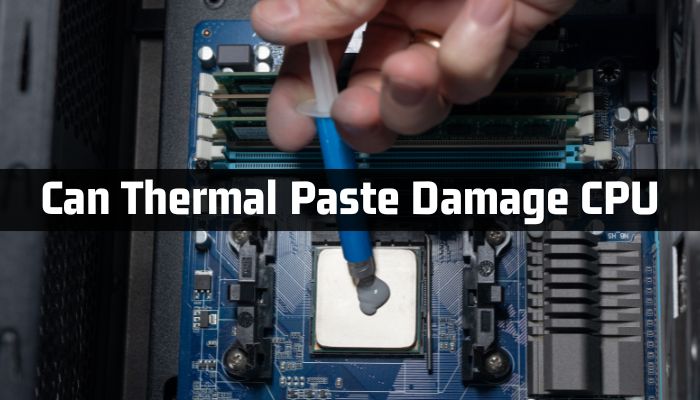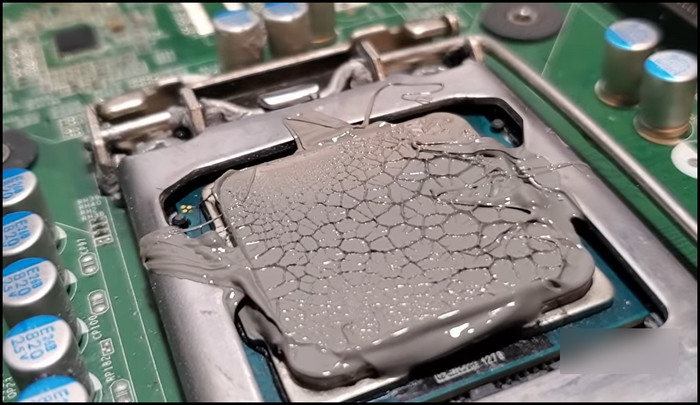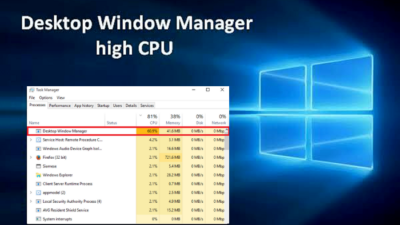While building a new PC and applying the thermal paste, a small amount of paste can spill over outside the processor.
At that moment, a question like whether the thermal paste is harmful to your CPU may hit on your head.

If it did, then tag along. In this article, I will discuss this topic in detail. I will also cover some points related to this content for your convenience.
So, without wasting any more time, let’s begin.
Can Thermal Paste Damage the Processor?
Whether the thermal paste will damage a CPU depends on which type of thermal compound you use. If the paste is non-conductive, it will cause no harm. If the paste contains any conductive material, a short circuit will cause between the motherboard and other PC components.
There are a lot of conductive and non-conductive thermal pastes you will find in the market. Arctic Silver 5, Noctua NT-H1, Cooler Master MasterGel Maker, Thermal Grizzly Conductonaut, Gelid Solutions GC-Extreme, etc., are conductive thermal paste examples.
And, Arctic MX-4, Noctua NT-H2, Cooler Master MasterGel Pro, Thermal Grizzly Kryonaut, Phanteks PH-NDC, etc., are examples of non-conductive thermal paste.
How can you know whether the paste is conductive or non-conductive? It’s pretty simple.
Check the package that comes with the paste. There should be a label on the package which will state whether the paste is conductive or non-conductive. 
Moreover, other things, such as improperly applying the thermal compound, can also damage the CPU.
If you take too much thermal paste on the CPU and apply it, extra ones will spill over the edge of the processor and will drop on the motherboard or in the socket. This additional one, which spills on the motherboard, can create a short circuit and cause electrical damage.
You may now ask if I use a small amount of thermal paste, can it also damage the CPU?
Unfortunately, yes. When you apply a minor quantity of paste, an air pocket or gap create between the processor and the heat sink.
Thermal conductivity will reduce because of that and cause the processor to overheat. And, I bet you already know, heat is the main enemy of the CPU.
So, the point is that as long as you don’t apply the paste inappropriately, and it doesn’t contain metallic particles, you don’t need to worry about damage to your processor.
Go to the following section if you want to know what will happen if you apply the paste on the CPU more than necessary.
Are you thinking about using a thermal pad? Then read which one will be better, between thermal paste and thermal pad.
What Happens If You Put Too Much Thermal Paste on a CPU?
When you use an excessive amount of thermal paste on the processor, high-temperature issues can occur. Moreover, other serious problems, such as CPU throttling and system instability, may arise due to the overuse of thermal paste. Besides, the paste will be wasted.
If you apply the paste, and it becomes too thick, it will act as an insulator.
This means whatever the heat will generate in the CPU will trap and won’t properly dissipate to the cooler. As a result, the processor’s temperature will rise to a critical level, which is unsafe for any CPU.
Due to this high temperature, the CPU’s lifespan will start to shorten, or worse, it will damage permanently.
Moreover, CPU throttling will start because of overheating. It’s one kind of defense mechanism that is pre-built on your desktop and laptop computer. Throttling reduces the CPU’s performance to protect it. And due to that, the system performance gets lower.
That doesn’t end here. Overheating also leads to numerous system instability incidents, such as crashes, freezes, unexpected shutdowns, etc.
Additionally, you should not waste thermal paste by overusing it on one CPU.
You will be surprised to know that if you use the right amount of paste, with 3.5 grams of a tube, you can apply the paste in more or less 20 to 30 CPUs.
It’s quite a lot. After applying it to your processor, you can start a small business by lending it to some of your friends or others. Jokes apart, don’t do that, or they may call you cheap.
So, as you can see, many consequences will occur when you use too much paste. So, how much thermal paste should you apply then? I will discuss that in the following section.
How Much is Too Much Thermal Paste
Unfortunately, there is no exact amount to tell. CPU manufacturers say the correct amount is not too much. It doesn’t indicate the actual figure. But, from some PC experts and having practical experience, more than a pea-sized or rice-grain amount of thermal paste will be too much.
Though the quantity may seem a bit small, the amount is sufficient to cover the whole top surface of the CPU.
If you take more than that, the excess paste will ooze out the side of the CPU and create a mess. Trust me; this will not look so pleasant. 
If you want to avoid this kind of situation, you must know how much thermal paste is the right amount and the correct way to apply it.
But remember, the layer of the thermal paste should be as flimsy as possible. Around 0.3 ml will be enough. I know it’s hard to ensure that. However, the 0.3ml-0.4ml range is plenty for a 4 x 4 cm CPU. Try to keep the limit around that.
You can use a credit card or plastic card to spread the thermal paste. Sometimes you can get a tool for that with the package. You can also utilize that.
Make sure the layer is not so thick. Making it thicker will stop the cooler from getting into full contact with the processor. It will also hold the heat from transferring from the CPU to the heatsink.
This will make the processor hotter than it should, and your PC will experience several consequences.
How to Apply Thermal Paste on a CPU
To apply new thermal paste, you must clean the old layer of paste first, if there is any. Take a pea-sized amount of thermal compound on the processor’s surface and spread it all with a plastic card. However, the paste will automatically spread out when you install the cooler.
The paste-applying process seems to be quite straightforward, doesn’t it? I was excited when I applied the paste to my AMD Ryzen 7 7700X processor. The process is the same for the Intel processor.
However, to do all this, you will require some tools first. Check out the list below.
Here are the materials you will need to apply the thermal paste on the processor:
- Thermal paste.
- Rubbing alcohol / Isopropyl alcohol.
- Microfiber cloth.
- Small plastic card or spatula.
- Gloves (optional but recommended).
Once you have all these tools, you can take your step toward applying the thermal paste. Below I have explained the process in detail.
Here is the way to implement the thermal paste on the CPU:
1. Clean the Old Paste from the CPU and Cooler
First, remove all the solidified thermal paste from the processor and cooler. To do that, give a quick rub with the microfiber cloth. Use the spatula if the paste sticks to the surface tightly and doesn’t come off. Try to scratch out as much as possible with it.
Now soak the microfiber cloth with some alcohol and remove the residual paste. Before you use methylated spirits, read our quick guide first to know whether you can use methylated spirits to clean the CPU thermal paste.
Gently rub the surface and make sure you remove all the paste that is leftover on the CPU’s IHS.
Do the same thing with the heatsink. Once the cleaning is complete, go to the next step.
2. Put the Paste on the CPU in a Certain Way
The next step is to apply the thermal paste, and you must do it in a certain way so that the paste can distribute all over the surface.
There are several ways, such as Blob, Pea, Rice grain, the ‘X,’ Spiral, Square, Penta Dot, A Smiley Face, Buttered Toast, or Buttered Toast with Jam, etc., you can exercise to apply the thermal paste.
But among them, the pea and the X method is quite popular. But, I prefer the Buttered Toast with Jam method. With this, the paste spreads very well, and no air gap creates.
Additionally, it’s up to you which paste (conductive or non-conductive) you want to apply to the processor. But before you think about using toothpaste, read first whether it is ok to use toothpaste as Thermal Paste on the CPU.
Note: Use a pea-sized amount of thermal paste. Too much paste can spill over the processor and can cause damage to the motherboard and socket.
3. Spread the Paste All Over the IHS Surface
Now it’s time to distribute the compound all over the CPU’s IHS surface. However, you may directly place the cooler without spreading it. But most of the time, the paste doesn’t distribute across the surface evenly.
It’s better if you do the spreading process manually by yourself. To do that, use a small plastic card or spatula. And, ensure the paste covers the entire surface of the CPU’s IHS.
Note: Don’t make the paste layer too thick.
4. Install the Heatsink and Check the Temperature
After the spreading, you have to install the heatsink. To do that, place the cooler on top of the CPU. Screw the cooler properly to the motherboard. Ensure the cooler properly sits on the processor and is securely attached.
After that, test the temperature of the CPU. If you see the temperature is in the optimum range, you have done an excellent job applying the paste.
Unless the temperature is too high and getting higher over time, you may need to reapply the thermal paste.
FAQs
How do I clean thermal paste off my CPU?
To clean the thermal paste off the CPU, take a paper towel & a cotton swab, and soak a small amount of isopropyl alcohol into it. Carefully, rub the top of the processor with the towel. Use the cotton swab to clean the paste from the plate and the remaining left outside.
How long does thermal paste last?
The thermal paste can last up to a minimum of 2 years. It can sustain on the CPU for about 4 years or more at maximum.
Is thermal paste really necessary?
Yes, thermal paste is necessary and one of the vital components for the CPU and cooler. Without it, air bubbles will build. The processor won’t be able to transfer its heat to the cooler.
Final Thought
Thermal paste is one of the crucial components of the processor and cooler. It contributes significantly to the CPU by dissipating the heat to the cooler during operation. So, use a good-quality paste on the processor.
I hope you have got all your answers from here. Comment below if you have any questions. I will be glad to answer them.
Peace!




